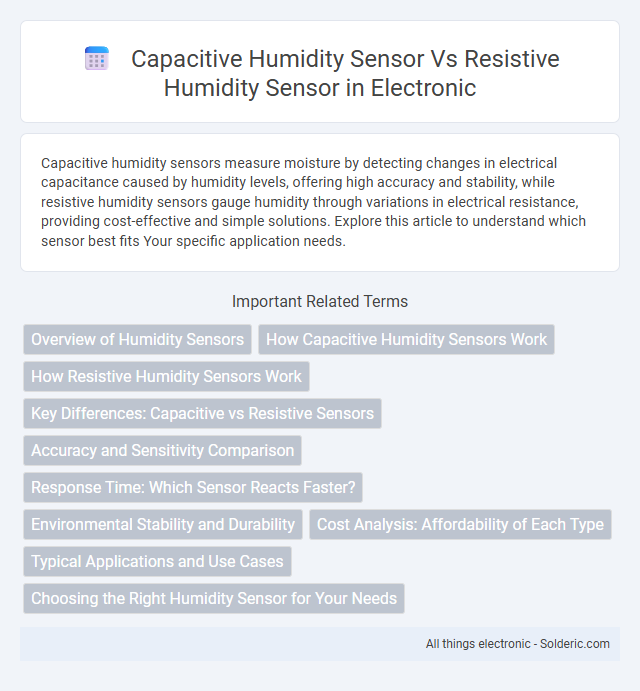Capacitive humidity sensors measure moisture by detecting changes in electrical capacitance caused by humidity levels, offering high accuracy and stability, while resistive humidity sensors gauge humidity through variations in electrical resistance, providing cost-effective and simple solutions. Explore this article to understand which sensor best fits Your specific application needs.
Comparison Table
| Feature | Capacitive Humidity Sensor | Resistive Humidity Sensor |
|---|---|---|
| Measurement Principle | Changes in capacitance due to humidity | Changes in electrical resistance due to humidity |
| Accuracy | High accuracy (+-2-3% RH) | Moderate accuracy (+-3-5% RH) |
| Response Time | Fast response (seconds) | Slower response (tens of seconds) |
| Temperature Dependence | Low temperature dependence | Higher temperature dependence |
| Stability and Reliability | High long-term stability | Prone to drift over time |
| Cost | Moderate to high cost | Low cost |
| Applications | HVAC, weather stations, industrial control | Consumer electronics, basic humidity detection |
| Power Consumption | Low power consumption | Typically higher power consumption |
| Humidity Range | 0% to 100% RH | Generally 10% to 90% RH |
Overview of Humidity Sensors
Capacitive humidity sensors measure relative humidity by detecting changes in the dielectric constant of a hygroscopic polymer or metal oxide layer, offering high sensitivity and stability. Resistive humidity sensors operate by measuring the change in electrical resistance of a humidity-sensing material, typically a conductive polymer or salt, as moisture levels vary. Capacitive sensors generally provide better accuracy and faster response times, while resistive sensors are often favored for low-cost and simpler applications.
How Capacitive Humidity Sensors Work
Capacitive humidity sensors measure moisture by detecting changes in the dielectric constant of a polymer or metal oxide sensing layer as it absorbs water vapor. Your device relies on this variation in capacitance to provide accurate and reliable humidity readings over a wide range of conditions. These sensors are preferred for their stability, fast response time, and minimal drift compared to resistive humidity sensors.
How Resistive Humidity Sensors Work
Resistive humidity sensors measure moisture by detecting changes in the electrical resistance of a hygroscopic conductive polymer or salt deposit as it absorbs or releases water vapor. The sensor's resistive element varies resistance proportionally to the ambient relative humidity, allowing precise humidity measurement. This method offers advantages in cost-effectiveness and sensitivity but can be influenced by temperature and contamination over time.
Key Differences: Capacitive vs Resistive Sensors
Capacitive humidity sensors measure humidity by detecting changes in the dielectric constant of a polymer or metal oxide film, offering higher accuracy and stability in varying environmental conditions. Resistive humidity sensors rely on changes in electrical resistance of a hygroscopic conductive layer, which can be affected by contaminants and temperature fluctuations, resulting in lower precision. You should choose capacitive sensors for applications requiring precise and reliable humidity readings, while resistive sensors may be suitable for cost-sensitive or simpler humidity detection tasks.
Accuracy and Sensitivity Comparison
Capacitive humidity sensors offer higher accuracy and sensitivity than resistive humidity sensors due to their stable dielectric material, which responds precisely to changes in humidity levels. Resistive sensors, while often more cost-effective, tend to exhibit non-linear responses and suffer from drift over time, reducing measurement reliability. Your choice should prioritize capacitive sensors for applications demanding precise humidity control and consistent sensitivity.
Response Time: Which Sensor Reacts Faster?
Capacitive humidity sensors generally exhibit faster response times than resistive humidity sensors due to their ability to quickly detect changes in the dielectric constant of the sensing material. The thin dielectric polymer layer in capacitive sensors allows rapid moisture absorption and desorption, enabling swift humidity reading updates typically within seconds. Resistive sensors, relying on moisture-induced changes in electrical resistance, often have slower reaction times because of the thicker moisture-absorbing layers and longer stabilization periods.
Environmental Stability and Durability
Capacitive humidity sensors offer superior environmental stability and durability due to their insulation-based sensing mechanism, which resists contamination and moisture-induced degradation over time. Resistive humidity sensors, in contrast, are more susceptible to changes in ambient conditions, leading to potential drift and reduced lifespan when exposed to harsh environments or prolonged humidity. For your applications requiring long-term reliability in varying environmental conditions, capacitive sensors provide a robust solution with consistent performance.
Cost Analysis: Affordability of Each Type
Capacitive humidity sensors generally offer higher accuracy but come at a higher initial cost compared to resistive humidity sensors, which are more affordable and widely used in budget-sensitive applications. Resistive sensors have simpler construction and materials, leading to lower production costs, making them ideal for large-scale deployments where cost efficiency is critical. Your choice depends on balancing affordability with performance requirements, as capacitive sensors provide longer-term stability justifying their higher price.
Typical Applications and Use Cases
Capacitive humidity sensors are commonly used in HVAC systems, weather stations, and medical devices due to their accuracy and stability in monitoring relative humidity. Resistive humidity sensors find frequent application in consumer electronics, automotive climate control, and industrial process monitoring thanks to their cost-effectiveness and fast response times. Your choice between these sensors depends on the specific requirements for precision, environmental conditions, and budget constraints in your project.
Choosing the Right Humidity Sensor for Your Needs
Capacitive humidity sensors offer higher accuracy and faster response times, making them ideal for precise environmental monitoring, while resistive humidity sensors are more cost-effective and suitable for applications with less stringent accuracy requirements. Your choice depends on factors like budget, required sensitivity, and operating conditions; capacitive sensors perform better in varying temperature and humidity ranges, whereas resistive sensors excel in simpler, low-cost setups. Consider the sensor's stability, durability, and compatibility with your system to ensure optimal performance and reliable humidity measurements.
capacitive humidity sensor vs resistive humidity sensor Infographic

 solderic.com
solderic.com